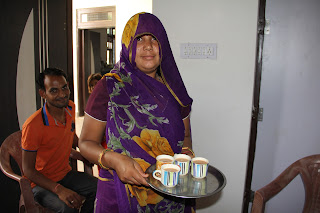With shopping becoming more of an online experience, retail outlets are facing a challenge to stay afloat in many parts of the world. These days, consumers choose to invest in experiences rather than products. My most recent adventure of running Maka Maka’s flagship store and café in Kolkata, India taught me invaluable lessons for surviving in a market that is tech savvy and more inclined to buying online. The target customer for us is well-heeled, educated, curious, and has an admiration and appreciation for handcrafted and curated products coupled with a liking for eclectic fares in a café.
Experiential Shopping was what excited our customers the most, given that we were a "travel inspired" concept store and cafe. By creating a more immersive retail experience, we ensured that the customer left with memories, and not just with products or food items. Being able to enjoy our balcony seating, that overlooked a park, created many pleasant memories for a lot of our Cafe patrons, particularly the younger ones. Some of them lived outside of Kolkata and they came back with friends and family each time they visited the city!
For us, the core of customer retention was the experience they had while shopping at Maka Maka and enjoying the eclectic offerings in our café. Here are a few “stories” that will help illustrate my point on how to engage and delight customers:
Experiential Shopping
Most patrons enjoyed the aesthetics of the space, which, to them felt like a journey through my travels across the world or within India. They stopped to enjoy the photographs on the walls and asked questions about Machu Picchu or Patagonia or Rajasthan and even about certain artisans I had met during my travels. It established a certain rapport with the customers as I shared my travel stories. When they entered Maka Maka, they felt relaxed and lingered, sipping on cappuccino and browsing through our curated collection. It became an enjoyable escape.
Telling a Story
Our store décor almost resembled that of a gallery with white walls adorned with vibrant photographs of our Artisans. This made customers feel more connected to the artisans’ crafts, and helped generate a feeling of vested interest in supporting them. Every customer at Maka Maka loved hearing the stories of the artisans and their craft heritage.
Our customers appreciated the collection as they understood the effort that went behind curating an assortment that was hand-picked for their refined palettes.
Encouraging Local Designers and Hosting Pop-Up Shows
We always encouraged young Fashion Designers or Culinary Experts to showcase their designs and food items through Pop-Up shows that we co-hosted. This offered our patrons a sneak peek at some new, undiscovered talent as well as first dibs on their creations. Our patrons thoroughly enjoyed the informal nature of the Fashion Shows and felt they could relate to the designs better. We always had great sales at these events! This also helped us reach more people through an expanded network of suppliers/designers.
Paying Genuine Compliments to Customers
Our genuineness at making suggestions or paying compliments to the customers while helping in their buying process was much appreciated by them. There was an instance, when a patron came back with a friend to show Maka Maka’s collections. It so happened while she was shopping with us on an earlier occasion, we suggested to her to buy a clothing item that was not from our own collection but from another Designer’s which we carried in our store as we felt that it would suit her more. She heeded our suggestion and later received many compliments from friends and family, which in turn made her be highly appreciative of us. We felt this was our real reward.
Going the Extra Mile
We once had an out of town patron who bought a one of a kind silk saree from our collection and needed a matching blouse at short notice of less than 24 hours. I called a seamstress who made beautiful blouses to fulfill this customer's need. This assistance and outcome thrilled the customer immensely.
Understanding Our Patrons
When creating custom solutions for patrons, we always felt we needed to understand them better which would give us more insight in creating the right design for them. For example, a saree ensemble was designed for a patron to wear while attending a meeting with the Emperor and Empress of Japan. We could do this only after understanding her needs, as she was someone who rarely wore sarees. We also needed to be mindful of the gravity of the occasion.
Knowing the special needs of our customers and remembering them each time they visited us created a loyalty towards our brand. Our Baristas always remembered certain preferences of our regular patrons, such as, how someone liked to take their tea and what kind of tea they preferred.
Having a Great "Team Maka Maka"
It would be unfair if the importance of the team at Maka Maka was understated. Their dedication in serving the customers was of the highest order, basis our underlying values and principles of customer service. They took personal responsibility in ensuring every customer was delighted, be it while going through the shopping experience or relaxing in the Café with their food and beverage of choice. I can't thank them enough!



































.jpg)
.jpg)
.jpg)
.jpg)

%2B(607x683).jpg)

.jpg)
.jpg)
.jpg)
.jpg)
.jpg)
